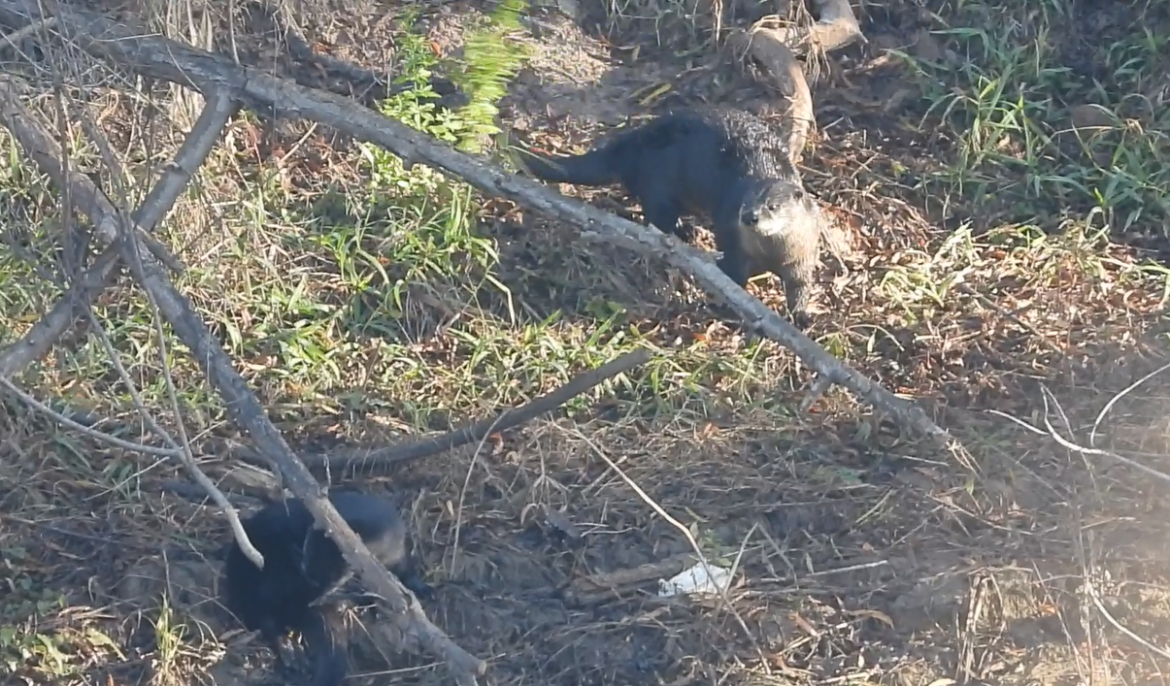By: Ashley Van Wieren
During a recent Christmas Bird Count in Brazoria County, Celeste Silling, Director of Education and Outreach at Gulf Coast Bird Observatory, and I were walking together when loud splashes sounded from an adjacent river. “We saw two little creatures swimming in the river, and as soon as they jumped out, we could tell by their long slender bodies and shiny brown coats that they were otters,” Silling recounts.
Otters are very elusive and avoid areas of human activity, so sightings can be rare. “It was really exciting because I had never seen a river otter before and they weren’t just darting past for a few seconds. They were playing and cuddling right in front of us,” she says. We watched the pair chase after one another through the water, then tumble along the banks. I immediately noticed that their appearance and playful behavior were strikingly similar to the anatomy and behavior of my pet ferrets. This makes sense as they both belong to the family Mustelidae.
North American river otters have a small head with relatively small ears, a streamlined body, water-proof coats, and webbed toes. These features help the otters adapt to their semi-aquatic lifestyle by making them powerful and agile swimmers. Long and sensitive whiskers help to detect prey in waters with low visibility and sharp unretractable claws are utilized by latching onto slippery fish looking to make a quick escape.
These claws, paired with a powerful jaw, come in handy when defending themselves against natural predators like alligators and coyotes. Although they are referred to as the river otter, they occupy a diverse range of aquatic habitats. These habitats include rivers, streams, lakes, ponds, and wetlands throughout North America; they can even be spotted locally in East Texas.
River otters are highly social. They play together and are also known to hunt together. They will travel long distances together in search of food, but they also don’t shy away from hunting solo. The bulk of their diet consists primarily of fish and crawfish, although otters have even been spotted teaming up to take down larger prey on rare occasions.
They use scent as well as a wide range of vocalizations to communicate with each other. Otters mate in early spring, and the gestation period lasts just two months. They will take the den of another animal (occupied or not) and raise their litter of one to three pups. At just two months of age, mom takes them for their first swimming lessons and they will leave the family before the arrival of mom’s next litter.
Habitat loss, pollution, and overhunting had once caused the decline of river otter populations in the 19th and 20th centuries. Conservation efforts including those that clean the waterways and reintroduction programs have been largely successful in recovering the once declining populations. The North American river otter is currently listed as least concerned by the IUCN Red List of Threatened Species.
To help clean coastal habitat for local wildlife, bring friends and family out to Nest Fest March 12th! Help remove marine debris at sites along Galveston Island, Follet’s Island, and Bolivar Peninsula to provide safe and clean beaches for nesting birds and sea turtles! Visit www.splashtx.org to learn more and volunteer.
Photo caption: River Otters seen playing during Columbia-Brazoria Bottomlands Christmas Bird Count.
Photo by Celeste Silling

